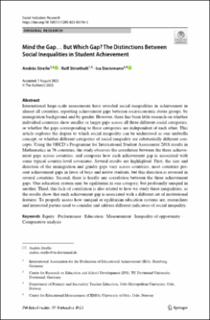| dc.description.abstract | International large-scale assessments have revealed social inequalities in achievement in almost all countries, reporting achievement gaps between socioeconomic status groups, by immigration background and by gender. However, there has been little research on whether individual countries show smaller or larger gaps across all three different social categories, or whether the gaps corresponding to these categories are independent of each other. This article explores the degree to which social inequality can be understood as one umbrella concept, or whether different categories of social inequality are substantially different con- cepts. Using the OECD’s Programme for International Student Assessment 2018 results in Mathematics in 76 countries, the study observes the correlation between the three achieve- ment gaps across countries, and compares how each achievement gap is associated with some typical country-level covariates. Several results are highlighted. First, the size and direction of the immigration and gender gaps vary across countries; most countries pre- sent achievement gaps in favor of boys and native students, but this direction is reversed in several countries. Second, there is hardly any correlation between the three achievement gaps. One education system may be egalitarian in one category, but profoundly unequal in another. Third, this lack of correlation is also related to how we study these inequalities, as the results show that each achievement gap is associated with a different set of institutional features. To properly assess how unequal or egalitarian education systems are, researchers and interested parties need to consider and address different indicators of social inequality. | en_US |

